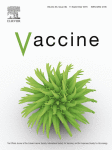Ver ítem
- xmlui.general.dspace_homeCentros e Institutos de InvestigaciónCICVyA. Centro de Investigación en Ciencias Veterinarias y AgronómicasInstituto de VirologíaArtículos científicosxmlui.ArtifactBrowser.ItemViewer.trail
- Inicio
- Centros e Institutos de Investigación
- CICVyA. Centro de Investigación en Ciencias Veterinarias y Agronómicas
- Instituto de Virología
- Artículos científicos
- Ver ítem
Development of an APC-targeted multivalent E2-based vaccine against Bovine Viral Diarrhea Virus types 1 and 2
Resumen
The aim of this study was to develop and test a multivalent subunit vaccine against Bovine Viral Diarrhea Virus (BVDV) based on the E2 virus glycoprotein belonging to genotypes 1a, 1b and 2a, immunopotentiated by targeting these antigens to antigen-presenting cells. The E2 antigens were expressed in insect cells by a baculovirus vector as fusion proteins with a single chain antibody, named APCH I, which recognizes the β-chain of the MHC Class II antigen.
[ver mas...]
The aim of this study was to develop and test a multivalent subunit vaccine against Bovine Viral Diarrhea Virus (BVDV) based on the E2 virus glycoprotein belonging to genotypes 1a, 1b and 2a, immunopotentiated by targeting these antigens to antigen-presenting cells. The E2 antigens were expressed in insect cells by a baculovirus vector as fusion proteins with a single chain antibody, named APCH I, which recognizes the β-chain of the MHC Class II antigen. The three chimeric proteins were evaluated for their immunogenicity in a guinea pig model as well as in colostrum-deprived calves. Once the immune response in experimentally vaccinated calves was evaluated, immunized animals were challenged with type 1b or type 2b BVDV in order to study the protection conferred by the experimental vaccine.
The recombinant APCH I-tE21a-1b-2a vaccine was immunogenic both in guinea pigs and calves, inducing neutralizing antibodies. After BVDV type 1b and type 2 challenge of vaccinated calves in a proof of concept, the type 1b virus could not be isolated in any animal; meanwhile it was detected in all challenged non-vaccinated control animals. However, the type 2 BVDV was isolated to a lesser extent compared to unvaccinated animals challenged with type 2 BVDV. Clinical signs associated to BVDV, hyperthermia and leukopenia were reduced with respect to controls in all vaccinated calves. Given these results, this multivalent vaccine holds promise for a safe and effective tool to control BVDV in herds
[Cerrar]

Autor
Pecora, Andrea;
Malacari, Darío Amilcar;
Pérez Aguirreburualde, María Sol;
Bellido, Demian;
Nuñez, Maria del Carmen;
Dus Santos, Maria Jose;
Martínez Escribano, José Angel;
Wigdorovitz, Andres;
Fuente
Vaccine 33 (39) : 5163-5171. (22 September 2015)
Fecha
2015-09
Editorial
Elsevier
ISSN
0264-410X
Formato
pdf
Tipo de documento
artículo
Palabras Claves
Derechos de acceso
Restringido
 Excepto donde se diga explicitamente, este item se publica bajo la siguiente descripción: Creative Commons Attribution-NonCommercial-ShareAlike 2.5 Unported (CC BY-NC-SA 2.5)
Excepto donde se diga explicitamente, este item se publica bajo la siguiente descripción: Creative Commons Attribution-NonCommercial-ShareAlike 2.5 Unported (CC BY-NC-SA 2.5)

